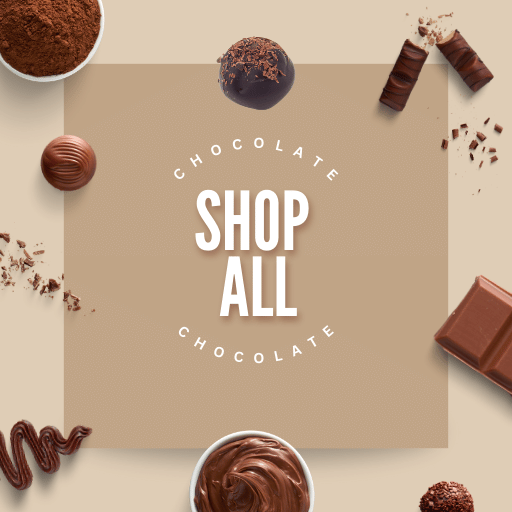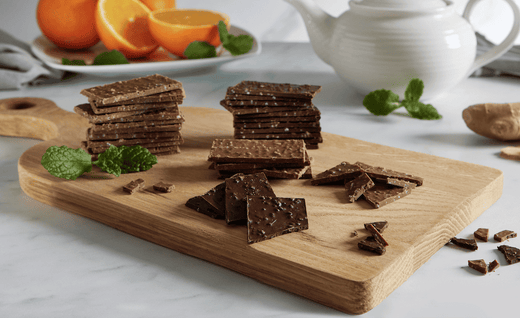Who doesn’t love chocolate?
It’s one of the most universally adored treats worldwide, with its rich, creamy taste and seemingly endless varieties.
But have you ever wondered where this beloved food comes from and how it has evolved?
In this post, we’ll explore the fascinating history of chocolate, from its humble beginnings in Mesoamerica to its widespread popularity today.
Get ready to learn about the sweet and surprising journey of one of the world’s favourite foods!
When Was Chocolate Invented?
The use of cacao beans, used to make chocolate dates back at least 4,000 years to ancient Mesoamerica, where the Aztecs and Mayans cultivated cacao trees and used the beans to make a bitter beverage.
However, the chocolate that we know today, which is sweeter and creamier than the ancient beverage, was developed much later.
The first chocolate bar was created in 1847 by British chocolate maker J.S. Fry & Sons, who figured out how to mix cocoa powder, sugar, and cocoa butter to create a moldable chocolate paste that could be formed into bars.
So, while cacao beans have been used for thousands of years, modern chocolate as we know it today didn’t exist until the mid-19th century.
(You might also want to read this blog post looking at the question: how is chocolate made step-by-step?)
Who Invented White Chocolate?
White chocolate which is made from cocoa butter, sugar, milk solids, and vanilla, was first invented by the Swiss chocolate company Nestlé in the 1930s.
Specifically, a Swiss chocolatier named Peter Schlumpf developed the first white chocolate recipe for Nestlé in 1930.
White chocolate has a milder flavour than traditional plain, dark or milk chocolate and doesn’t contain any cocoa solids responsible for the characteristic chocolate flavour.
Instead, white chocolate has a creamy, buttery taste from cocoa butter.
While there is debate over whether white chocolate can be considered “real” chocolate since it doesn’t contain cocoa solids, it remains a popular and beloved treat worldwide.
(You might also be interested in this blog post asking: what is chocolate, and why is it so tasty?)
When Did Chocolate Arrive in the UK?
Chocolate was first introduced to the United Kingdom in the early 17th century.
The first recorded shipment of cocoa beans to England was in 1585, but it wasn’t until the early 1600s that the wealthy elite consumed chocolate as a drink.
In 1657, the first English chocolate house was opened in London, where customers could drink hot chocolate and socialise.
These chocolate houses were popular places for the wealthy and intellectuals of the day and played an essential role in developing English coffeehouse culture.
By the 18th century, chocolate had become more widely available and affordable, and it began to be used in various desserts and confections.
In the 19th century, the development of new technologies allowed for the mass production of chocolate, and it became a famous and beloved treat for people of all social classes.
Today, the UK is one of the world’s largest consumers of chocolate, with a thriving domestic chocolate industry and a deep love for all things cocoa.
The Evolution of Chocolate
The evolution of chocolate spans thousands of years and includes a rich history of cultural, technological, and scientific advances.
Here is a brief overview of the significant milestones in the evolution of chocolate:
-
Ancient Mesoamerica: The use of cacao beans, which are used to make chocolate, dates back at least 4,000 years to ancient Mesoamerica, where the Aztecs and Mayans cultivated cacao trees and used the beans to make a bitter beverage.
-
European Discovery: The first Europeans to encounter chocolate were the Spanish conquistadors, who were introduced to it by the Aztecs in the early 16th century. Chocolate became popular among the Spanish elite and was eventually brought to other parts of Europe.
-
Industrial Revolution: The development of new technologies during the Industrial Revolution allowed for the mass production of chocolate. For example, in 1828, Dutch chemist Coenraad Van Houten developed a process for removing the fat from cacao beans, resulting in the creation of cocoa powder, which made chocolate more affordable and accessible to the masses.
-
Modern Chocolate: In the late 19th and early 20th centuries, chocolate underwent a significant transformation as new processes were developed for mixing cocoa powder, sugar, and cocoa butter to create a moldable chocolate paste that could be formed into bars and other confections.
Today, chocolate is enjoyed worldwide in various forms, from chocolate bars and truffles to hot cocoa and chocolate-flavoured desserts.
Throughout its long and storied history, chocolate has been enjoyed as a symbol of luxury, love, and indulgence.
Its evolution continues to this day as new varieties and flavour combinations are developed and commercialised.
(Take a look at this post if you are interested in reading about: What is cacao?)
The Future of Chocolate
The future of chocolate is likely to be shaped by several factors, including advances in technology, changes in consumer preferences and behaviour, and efforts to address health, sustainability and social responsibility issues.
Here are some of the trends and developments that may shape the future of chocolate:
-
Health and Wellness: As consumers become more health-conscious, there is a growing interest in chocolate that is lower in sugar and fat and contains functional ingredients such as probiotics, antioxidants, and fibre.
-
Sustainability: There is a growing awareness of chocolate production's environmental and social impact, and efforts are underway to develop more sustainable and responsible supply chains. This includes initiatives to reduce deforestation, promote fair trade, and support local communities.
-
Innovation: The development of new technologies and ingredients will likely continue to drive innovation in the chocolate industry, with unique flavour combinations, textures, and formats being explored.
-
Personalisation: With the rise of digital technology, there is an opportunity to offer more personalised chocolate experiences, including customised products and packaging and interactive and immersive online experiences.
-
Alternative Sources: The search for new sources of chocolate is also ongoing, with research being conducted on the potential of alternative sources of cocoa, such as white cacao and other crops.
The future of chocolate is likely to be shaped by tradition and innovation as the industry seeks to balance the demand for high-quality, delicious chocolate with concerns for sustainability, health, and social responsibility.
(Check this post out if you are interested in the question: how many squares of dark chocolate per day?).
The History and Future of Whitakers Chocolates
Our chocolate history is over 130 years ago when our great, great grandfather ‘John Whitaker’ started a little greengrocers shop in a small Yorkshire village.
Soon after opening, our beloved Aunt Ida (John’s daughter) had the passion and idea to start making chocolates and confectionery.
This is where the true chocolate journey began and became ingrained into the Whitaker family for generations (and still is today).
Literally, when I say the Whitaker family is passionate and obsessed about chocolate, that’s no exaggeration!
As you can imagine, the world of chocolate has changed over this time, but one thing Whitakers does well is change and adapt to the needs of our customers.
Yes, some of Aunt Ida’s recipes are no longer in production (some still are, though, such as fondant creams and wafers!).
Still, one thing always remains constant - our strong family values for producing the finest quality British chocolates at affordable prices.
We believe everyone should be able to afford a little luxury every day.
Now the fifth generation, run by myself and my husband William Whitaker, we live, sleep and eat chocolate.
We’re a powerful team, and with the help of the rest of the Whitakers team, we are always looking at ways to engage with our loyal following and create new chocolate experiences they will love.
This includes growing our vegan chocolate range, introducing Fairtrade Cocoa products and making more gluten-free products.
Here are just a few of our new products:
-
Dark chocolate Raspberry chocolate squares (vegan/fairtrade & gluten-free)
-
Milk chocolate and honeycomb Smoky Salted Caramel Inclusion bar (Fairtrade & gluten-free)
-
Dark chocolate Pink Gin fondant creams (vegan/fairtrade & gluten-free)
-
The original milk Mint crisps - now in larger tubs! (gluten-free)
So, looking to the future… we’ll be making more delicious chocolates with sustainability and health benefits being our primary focus.
Watch this space!
https://www.youtube.com/watch?v=-0ilm8WuhRg
(You may also like to read this post asking what chocolate is gluten-free UK?).
Why is Chocolate So Popular?
Chocolate is popular for many reasons, including its unique taste, texture, and aroma, as well as the emotional and physiological effects it can have on the body.
Here are some of the main reasons why chocolate is so popular:
-
Pleasure: Chocolate has a unique taste and texture that people of all ages and backgrounds widely enjoy. The combination of sweet and bitter flavours and the creamy texture make it a delightful and indulgent treat.
-
Emotional Benefits: Chocolate is often associated with positive emotions, such as happiness, comfort, and relaxation. This may be due in part to the release of endorphins and other “feel-good” chemicals in the brain that can be triggered by consuming chocolate.
-
Nutritional Value: Chocolate contains various nutrients, including antioxidants, fibre, and minerals such as iron, copper, and magnesium. Dark chocolate, in particular, is considered a healthy food and can provide health benefits when consumed in moderation.
-
Tradition: Chocolate has a long and rich history and has been enjoyed by people worldwide for centuries. It has been used in religious ceremonies, as a form of currency, and as a symbol of luxury and indulgence.
-
Versatility: Chocolate can be used in various forms and formats, from chocolate bars and truffles to hot cocoa and chocolate-flavoured desserts. It can be enjoyed as a snack, a dessert, or a drink, making it a versatile and popular food.
Chocolate is a beloved and popular food for many reasons, and its popularity is likely to continue for many years.
Final Notes On Where and When Chocolate Was Invented
In its most basic form, chocolate was discovered by the Aztecs and Mayans around 4000 years ago.
Modern chocolate as we know it today was invented much later on, but it is hard to specify when.
The first chocolate bar was invented in 1847 by a British chocolate maker who figured out how to mix cocoa powder, sugar, and cocoa butter to create a moldable chocolate paste which could then be formed into bars.
Thanks for reading this post and looking at the question - when was chocolate invented?
You might also like to read this that answers the question - where does chocolate come from?











